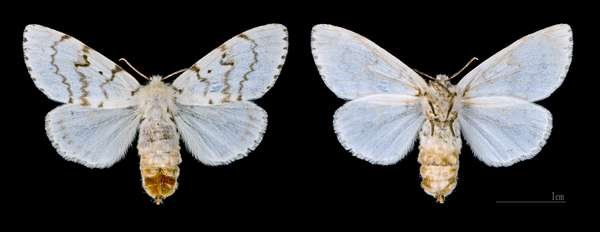Protect your home’s value: The “disgusting” invader causing chaos to West Coast forests
- Replies 0
The serene beauty of the West Coast's forests, a source of pride and joy for many homeowners, is under threat by an unassuming yet formidable enemy.
This invader, far from being a creature of science fiction, is a very real and “gross”pest. Its presence not only threatens the lush landscapes we cherish but also has the potential to wreak havoc on property values, leaving economic turmoil in its wake.
The creeping threat comes from the spongy moth (Lymantria dispar). Recent studies, including a January 6 report published in the prestigious journal Nature, have raised alarms about the spongy moth's march across the United States.
These beige-colored moths, which might seem harmless at first glance, are anything but. They have a voracious appetite for more than 300 species of trees and shrubs, making them an ecological nightmare.
The West Coast, known for its majestic oak forests that span millions of acres, is now at risk of becoming the next battleground.
Already, these pests have infiltrated parts of Southern and Northern California, with maps revealing their unsettling advance.

The spongy moth's journey to the United States is a tale of good intentions gone awry. Introduced in 1869 by scientist Leopold Trouvelot, who aimed to bolster the silk industry, these moths quickly became an uncontrollable force.
The caterpillars escaped, and without natural predators, they spread far and wide, carried by air currents.
For years, the Northeast managed to keep spongy moth populations in check, thanks to a natural ally: Entomophaga maimaiga, a fungal pathogen that preys on the moths.
However, climate change is weakening this defense, as the fungus requires cooler climates to thrive. With rising temperatures, the moths are expanding their range, and their potential for destruction grows.
The ecological toll of a spongy moth infestation is severe. These moths can defoliate trees, impairing their ability to photosynthesize, and repeated infestations can kill trees within two to three years.
But the damage doesn't stop there. The economic repercussions are equally alarming, with invasive insects costing the U.S. an estimated $40 billion annually in damages to crops, trees, and other plants.
One of the most immediate effects of a spongy moth invasion is on the housing market.
“Nobody wants to buy a house in an area where the trees don't have any leaves,” said Greg Dwyer, a University of Chicago ecology professor and study co-author.
The caterpillars' droppings, described as squishy and cellulose-like, accumulate in large, unpleasant piles, further depressing property values. “It's pretty gross,” Dwyer added, noting that the insects also cover houses and cars, which is “pretty disgusting too.”
Efforts to control the spongy moth population include manual methods like wrapping trees in burlap to trap larvae.
However, with the weakening of natural defenses like E. maimaiga due to global warming, containment becomes increasingly challenging.
Dwyer poignantly reminds us that climate change isn't just about polar bears in the Arctic; it's also about pests like the spongy moth in our own backyards.
The impending epidemic threatens to replicate the widespread devastation seen in last year's lanternfly invasion, which was fueled by a lack of natural predators and the insects' indiscriminate feeding habits.
Also read: Alien-like insect threatens 13 states

Have you noticed any signs of these pests in your area? What measures are you taking to protect your property? Let's come together to discuss and find solutions to this pressing issue in the comments below!
This invader, far from being a creature of science fiction, is a very real and “gross”pest. Its presence not only threatens the lush landscapes we cherish but also has the potential to wreak havoc on property values, leaving economic turmoil in its wake.
The creeping threat comes from the spongy moth (Lymantria dispar). Recent studies, including a January 6 report published in the prestigious journal Nature, have raised alarms about the spongy moth's march across the United States.
These beige-colored moths, which might seem harmless at first glance, are anything but. They have a voracious appetite for more than 300 species of trees and shrubs, making them an ecological nightmare.
The West Coast, known for its majestic oak forests that span millions of acres, is now at risk of becoming the next battleground.
Already, these pests have infiltrated parts of Southern and Northern California, with maps revealing their unsettling advance.

The West Coast is at risk of an invasion by the destructive spongy moth, Lymantria dispar, which could cause significant ecological and economic damage. Image source: Didier Descouens / Wikimedia Commons.
The spongy moth's journey to the United States is a tale of good intentions gone awry. Introduced in 1869 by scientist Leopold Trouvelot, who aimed to bolster the silk industry, these moths quickly became an uncontrollable force.
The caterpillars escaped, and without natural predators, they spread far and wide, carried by air currents.
For years, the Northeast managed to keep spongy moth populations in check, thanks to a natural ally: Entomophaga maimaiga, a fungal pathogen that preys on the moths.
However, climate change is weakening this defense, as the fungus requires cooler climates to thrive. With rising temperatures, the moths are expanding their range, and their potential for destruction grows.
The ecological toll of a spongy moth infestation is severe. These moths can defoliate trees, impairing their ability to photosynthesize, and repeated infestations can kill trees within two to three years.
But the damage doesn't stop there. The economic repercussions are equally alarming, with invasive insects costing the U.S. an estimated $40 billion annually in damages to crops, trees, and other plants.
One of the most immediate effects of a spongy moth invasion is on the housing market.
“Nobody wants to buy a house in an area where the trees don't have any leaves,” said Greg Dwyer, a University of Chicago ecology professor and study co-author.
The caterpillars' droppings, described as squishy and cellulose-like, accumulate in large, unpleasant piles, further depressing property values. “It's pretty gross,” Dwyer added, noting that the insects also cover houses and cars, which is “pretty disgusting too.”
Efforts to control the spongy moth population include manual methods like wrapping trees in burlap to trap larvae.
However, with the weakening of natural defenses like E. maimaiga due to global warming, containment becomes increasingly challenging.
Dwyer poignantly reminds us that climate change isn't just about polar bears in the Arctic; it's also about pests like the spongy moth in our own backyards.
The impending epidemic threatens to replicate the widespread devastation seen in last year's lanternfly invasion, which was fueled by a lack of natural predators and the insects' indiscriminate feeding habits.
Also read: Alien-like insect threatens 13 states
Key Takeaways
- The West Coast is at risk of an invasion by the destructive spongy moth, Lymantria dispar, which could cause significant ecological and economic damage.
- Rising temperatures attributed to climate change are facilitating the spread of the moths, which have the potential to devastate California's oak forests and other vegetation.
- The spongy moth invasion has economic consequences, including the potential to lower property values due to defoliated trees and accumulated caterpillar droppings that create an unpleasant environment.
- Control efforts are in place but challenged by warming climates that weaken natural defences such as the fungus Entomophaga maimaiga, making it imperative to find alternative solutions to curb the impending threat.
Have you noticed any signs of these pests in your area? What measures are you taking to protect your property? Let's come together to discuss and find solutions to this pressing issue in the comments below!






